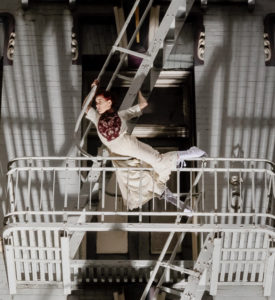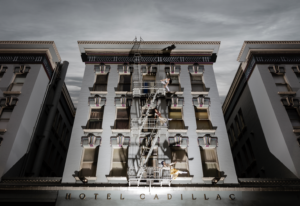If you are like me, you want artists who have an individual voice and the expertise to articulate it cogently. Some develop gradually; in others a special spark asks for attention from the minute you encounter it. Jo Kreiter is one of them. Maybe you first noticed her as a member of Zaccho Dance Theatre as a moving speck sitting on the numeral nine of the Ferry Building’s Clock Tower. It happened in Joanna Haigood’s 1995 Noon, which had the performers also rappel some two hundred vertigo-inducing feet to the ground. Two years later, Kreiter’s own dancers were hanging off windowsills and fire escapes in Sparrow Alley to live music by Pamela Z. They surprised both passers-by and residents.
A Political Science Major at Duke University, Kreiter came to San Francisco without any dance training. It was the city’s long activist tradition that attracted her. She stayed, and it became a good decision for her and the local dance community. By now Kreiter has some twenty-three choreographies to her credit, the vast majority of them are what she calls “aerial” or “apparatus-based” dance. Her budgets have grown; her accolades and grants are numerous.
Still, she has had a few setbacks. Some odder than others.
For her 20th anniversary concert in 2016, she created Grace and Delia Are Gone about violence against women. The music was based on murder ballads, many of them from 19th century folk traditions. The National Endowment for the Arts denied the grant proposal because as the panelists apparently said that these women should have gone to local shelters.
Right now Kreiter is hard at work on her largest site-specific project yet. Tender (n.) A Person Who Takes Charge (June 7-16) will be performed outside the Cadillac Hotel at 388 Eddy Street in one of San Francisco’s poorest neighborhoods.
Yet Kreiter is restless.

She easily acknowledges that her site-specific works have allowed her to engage in her two passions: social activism from a feminist perspective and dance. She is also aware that her outdoor installations greatly limit their touring potential. “I would like not to be known as a regional artist,” she muses in her kitchen in the Portola District before a meeting with long-time set designer Sean Riley. She would like Flyaway Productions to really take flight. “For instance,” she says, “it would be so nice if somebody, let’s say in Tennessee, had heard about what we do and called to explain that they had a certain situation, and would we like to come.”
Yet she already has come a long way. In 1990, still performing with Zaccho, she became a member of ODC’s first Pilot Project that encourages young choreographers to develop their potential. “I really didn’t know what I wanted to do,” she recalls but she does remember the supportive environment and that she wanted to make a “piece about wildness and that it was OK to be wild.”
Early on she also received much support by what she calls San Francisco’s “Senior Women Artists”: Haigood, Margaret Jenkins and Brenda Way. “I remember one day Brenda called me up and said she had heard about me; let’s have lunch.” And they did. “I wouldn’t be here without them,” Kreiter modestly acknowledges.
Her trapeze work with Terry Sendgraff and performing with Haigood had given her a framework of what she might do. She likes objects, any object, small, huge, round, pointed, fixed, floating. Kreiter embraces them because she sees possibilities. “My creativity is very naked without an object, “she admits. The simple act of walking vertically up a pole, for instance, exhilarated her. The gravitational pull became horizontal, and the vertical became the place on being grounded.
In addition to choreographing for her own group, for the last twelve years Kreiter has given summer workshops, “GIRLFLY” for underserved teenage girls. “They are body-focused,” she explains, “we address the body has a site of disempowerment and how they can change that.” She might not quite use that language, but the girls already have lots of stories to share about what it means to be male or female.
Looking for performers, Kreiter soon learned that traditional women’s dance training left them woefully shortchanged in upper body strength. That offended her feminist sensibility. To this day Flyaway is an all woman company. Her choreography is risk-based and demands upper-body strength, it is also dance-based, and many dancers already have acrobatic tendencies. Current company member Sonsherée Giles, for instance, is one of them. Experience has taught Kreiter that training dancers in her discipline is easier than training aerialists for dance. Laura Elaine Ellis, a “mature” dancer as she calls herself, wanted to broaden her skill set even as she was, as she says “attracted to the stories [Jo] she seeks to tell through her aerial dancing and apparatus.” As for her Flyaway training? “I am still working on strengthening and developing my aerial skills.”
 What about someone with fear of heights?
What about someone with fear of heights?
“Not for me,” Kreiter laughs.
As she has moved her creative energy to the Tenderloin, the subject matter has become increasingly dire.” For Tender she is working with immigrant Vietnamese people, the Tenderloin Museum and local Vietnamese community leaders. She will also include an employment component for local residents.
None of her works offer easy answers much as we would like them. But at the very least the stories about homelessness, about being ignored as women, about being exploited in the work force makes you (almost) believe that art and politics can have a symbiotic relationship. To see these dancers embrace the moment, and the sheer effort of their work instills hope even in a relatively straightforward work such as the 2003 How to be a Citizen. She had researched the decades old history of social protests along Market Street. She built a ramp on the lower part of the street on which the dancers struggled, climbed, slid and fell. But the ramp bent upwards as the women reached the end. A simple image perhaps, but potent and even hopeful.
Kreiter opts to work in the Tenderloin because “this is ground zero for income inequality in this City and this country. We don’t take care of the neediest people in our society, and they are there on the streets everyday.”
Not that it’s always easy. For example, rehearsing for the 2015 Needles to Thread meant working in an alley that functions as a public latrine. Yet even difficult can yield moments of beauty. A conversation with a resident about the work gave Kreiter feedback: “this is me.”
On a very hectic recent day as garbage was thrown around and a refrigerator kicked down the street, the neighborhood appeared to be a cauldron of fighting and screaming. Then dancers, in costumes for Tender, made their way to a photo shoot on a fire escape. All of a sudden, Kreiter remembers, “there was this moment of incredible calm and beauty even among all the chaos and pervasive trauma of an invasive street culture.”
Over the years Kreiter has developed a clear structural approach to each work. A year before the premiere, she starts collecting oral histories. For Tender, which looks at the experience of Vietnamese immigrants, she is working with seven dancers, drag artist Honey Maloney, the Asian Art and the Tenderloin museums, community and health organizations.
These stories will provide the work’s conceptual frame work. The material then gets divided into sections—four of them in the current piece. Then comes the music. For Tender the choreographer works for the first time with Emmy-winning composer Vân-Ánh Võ who also plays the zither, which functions prominently in Vietnamese culture.
If she knows and already is comfortable with a composer, the music’s creation can be very smooth. Pamela Z, who has worked with Kreiter since the 1996 Sparrows Alley, appreciates how very early in the process “Kreiter knows how the sections of the piece will be divided – with very precise durations, particular moods, tempi, and subject matter.” So Z often composes the score on her own. She finds it fascinating that somehow the different elements smoothly fit together.
The dance making comes at the very end of the process because the performers cannot command the site-specific space for long enough to realize the choreography. “My ideal,” Kreiter says somewhat dreamily, “is to create a work a hundred percent on location because the piece would have more longevity and, hopefully, engage the local residents more extensively.
Looking into the future, she repeats that, “I would really like to be invited rather than imposing myself.” To help the process along, she is designing a self-sustaining circular set for next year’s premiere that can be taken on the road.
Kreiter currently is a Rauschenberg Artist as Activist (2017-2019). This fellowship allows her to create—unusually—a very personal work. Waiting Room examines the love of women living with an incarcerated loved one. She knows whereof she is talking. “I am one of them,” she says. “My husband was incarcerated for six years.”
This article appeared in the May 2018 edition of In Dance.


